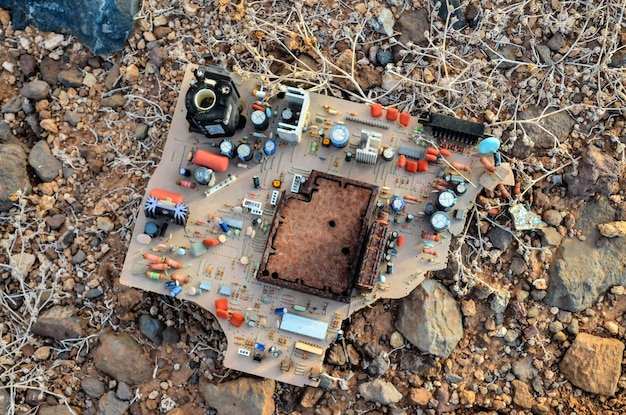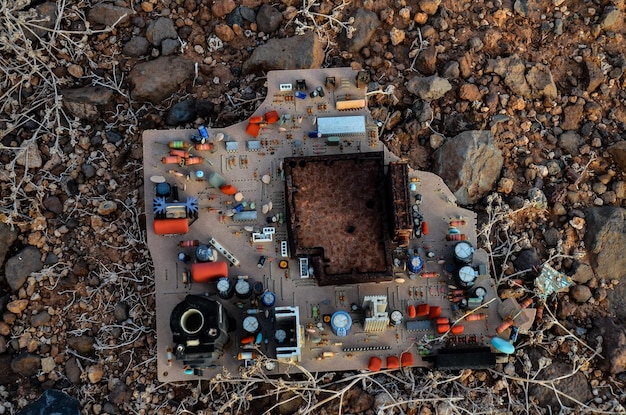The Environmental Impact of Consumer Tech: Reduce E-Waste Now

The environmental impact of consumer tech is substantial, primarily due to e-waste, but consumers can mitigate this by making informed purchasing decisions, extending the lifespan of devices, and responsibly recycling electronics to foster a more sustainable future.
The relentless march of technology brings incredible advancements, but it also leaves a trail of environmental consequences. Understanding the environmental impact of consumer tech: what you can do to reduce e-waste is crucial for a sustainable future.
Understanding the E-Waste Crisis
The sheer volume of electronic waste, or e-waste, generated globally is staggering. This section delves into the alarming statistics and explores the sources contributing to this growing crisis.
E-waste encompasses discarded electronic devices, from smartphones and laptops to refrigerators and televisions. The rapid pace of technological innovation, coupled with consumer demand for the latest gadgets, fuels a continuous cycle of obsolescence and disposal.
The Scale of the Problem
Consider these figures: According to the United Nations, the world generates over 50 million tons of e-waste annually, and this number is projected to reach 74 million tons by 2030. A significant portion of this waste ends up in landfills or is illegally shipped to developing countries.
Sources of E-Waste
Several factors contribute to the e-waste crisis. Planned obsolescence, where manufacturers intentionally design products with a limited lifespan, is a major culprit. Consumer behavior also plays a role, with many people replacing devices long before they are truly broken.
- Rapid Technological Advancements: New models and features entice consumers to upgrade frequently.
- Lack of Repair Options: Difficult or expensive repairs often lead to replacement rather than repair.
- Inadequate Recycling Infrastructure: Many regions lack the facilities and systems to properly recycle e-waste.
Addressing the e-waste crisis requires a multi-faceted approach, from manufacturers designing more durable and repairable products to consumers adopting more sustainable consumption habits. It also necessitates robust recycling infrastructure and effective regulations to prevent illegal dumping.
The Environmental and Health Impacts of E-Waste
The improper disposal of e-waste poses significant threats to both the environment and human health. This section examines the harmful substances found in electronics and the consequences of their release.
Electronic devices contain a cocktail of hazardous materials, including heavy metals like lead, mercury, and cadmium, as well as brominated flame retardants and other toxic chemicals. When e-waste is not properly recycled, these substances can leach into the soil, contaminate water sources, and pollute the air.

Environmental Consequences
The environmental consequences of e-waste are far-reaching. Soil contamination can disrupt ecosystems and harm plant life. Water contamination can affect aquatic life and make water unsafe for human consumption. Air pollution from burning e-waste can cause respiratory problems and contribute to climate change.
Health Risks
Exposure to the toxic substances in e-waste can have serious health consequences, especially for those involved in informal recycling operations in developing countries. These workers often lack protective gear and are exposed to hazardous fumes and direct contact with toxic materials.
- Neurological damage: Lead and mercury can impair brain function and cognitive development.
- Kidney damage: Cadmium exposure can lead to kidney disease.
- Respiratory problems: Inhaling fumes from burning e-waste can cause lung damage and respiratory illnesses.
Minimizing the environmental and health impacts of e-waste requires responsible recycling practices, proper handling of hazardous materials, and international cooperation to prevent the illegal dumping of e-waste in developing countries. Education and awareness are also crucial to inform consumers about the risks associated with improper e-waste disposal.
Extending the Lifespan of Your Devices
One of the most effective ways to reduce e-waste is to extend the lifespan of your electronic devices. This section offers practical tips on how to care for your electronics and make them last longer.
By taking simple steps to prolong the life of your devices, you can reduce the frequency with which you need to replace them, thereby decreasing your contribution to the e-waste stream. Proper care and maintenance can significantly extend the lifespan of your electronics.
Protective Measures
Investing in protective cases, screen protectors, and surge protectors can shield your devices from physical damage and power surges, common causes of failure. Regular cleaning and maintenance can also help prevent dust and dirt buildup, which can lead to overheating and malfunction.
Software Updates
Keeping your software up to date is crucial for maintaining the performance and security of your devices. Software updates often include bug fixes, security patches, and performance improvements that can enhance the longevity of your electronics.

Furthermore, consider these practices:
- Avoid Extreme Temperatures: Exposing your devices to extreme heat or cold can damage their components.
- Proper Storage: Store electronics in a cool, dry place when not in use.
- Battery Care: Follow the manufacturer’s recommendations for charging and storing batteries to maximize their lifespan.
By adopting these simple habits, you can significantly extend the lifespan of your devices, reduce e-waste, and save money in the long run. A conscious effort to care for your electronics is a step towards a more sustainable lifestyle.
Responsible Recycling: What You Need to Know
When your electronic devices reach the end of their lifespan, it’s crucial to recycle them responsibly. This section provides guidance on how to find certified recyclers and ensure your e-waste is handled properly.
Responsible recycling involves disassembling electronic devices and recovering valuable materials like gold, silver, and copper, while safely disposing of hazardous substances. Certified recyclers adhere to strict standards and regulations to protect the environment and human health.
Finding Certified Recyclers
Look for recyclers that are certified by reputable organizations like e-Stewards or R2 (Responsible Recycling). These certifications ensure that recyclers meet specific environmental and safety standards.
Proper Data Disposal
Before recycling your devices, be sure to erase all personal data. This may involve performing a factory reset, overwriting the hard drive, or physically destroying the storage media.
Keep these points in mind:
- Manufacturer Take-Back Programs: Many electronics manufacturers offer take-back programs for their products.
- Retailer Recycling Programs: Some retailers offer recycling services for electronics.
- Community Collection Events: Check with your local government for e-waste collection events in your area.
By recycling your electronics responsibly, you can help recover valuable resources, prevent pollution, and protect the environment. Making the effort to find certified recyclers ensures that your e-waste is handled in a safe and sustainable manner.
Making Sustainable Purchasing Decisions
The choices you make when purchasing electronics can have a significant impact on the environment. This section explores how to make more sustainable buying decisions, from choosing durable products to considering energy efficiency.
By prioritizing sustainability when buying electronics, you can reduce your environmental footprint and support companies that are committed to responsible practices. Informed purchasing decisions can drive positive change in the industry.
Durability and Repairability
Opt for durable products that are built to last. Look for devices that are easy to repair and have readily available replacement parts. A device with a longer lifespan reduces waste.
Energy Efficiency
Choose energy-efficient electronics that consume less power. Look for the Energy Star label, which indicates that a product meets specific energy efficiency standards.
Consider these sustainability factors:
- Eco-Labels and Certifications: Look for eco-labels and certifications that verify a product’s environmental performance.
- Recycled Content: Choose products made from recycled materials.
- Packaging: Opt for products with minimal and recyclable packaging.
Making informed purchasing decisions is a powerful way to promote sustainability in the consumer tech industry. By supporting companies that prioritize environmental responsibility, you can help drive positive change and create a more sustainable future.
The Role of Legislation and Corporate Responsibility
Addressing the e-waste crisis requires not only individual action but also strong legislation and corporate responsibility. This section examines the policies and practices that can promote more sustainable electronics management.
Government regulations and industry initiatives can play a crucial role in reducing e-waste and promoting responsible recycling. Effective legislation can prevent illegal dumping, encourage manufacturers to design more sustainable products, and ensure that recyclers adhere to high environmental standards.
Extended Producer Responsibility (EPR)
EPR policies hold manufacturers responsible for the end-of-life management of their products. This can incentivize them to design more durable and recyclable electronics.
Stricter Recycling Standards
Governments can establish stricter recycling standards and enforcement mechanisms to ensure that e-waste is handled properly and that hazardous materials are safely managed.
Companies can play their part by:
- Designing for Durability and Repairability: Creating products that last longer and are easier to repair.
- Using Recycled Materials: Incorporating recycled materials into their products.
- Offering Take-Back Programs:** Providing convenient recycling options for consumers.
Legislation and corporate responsibility are essential for creating a more sustainable electronics industry. By working together, governments, businesses, and consumers can reduce e-waste, protect the environment, and promote a circular economy.
| Key Point | Brief Description |
|---|---|
| ♻️ Reduce E-Waste | Minimize environmental impact by reducing the amount of electronic waste generated. |
| 🌱 Extend Lifespan | Prolong the life of devices through care and maintenance. |
| ♻️ Recycle Responsibly | Properly recycle electronics to recover materials and prevent pollution. |
| 🧐 Make Informed Choices | Choose durable, efficient, and eco-friendly products. |
Frequently Asked Questions
▼
E-waste refers to discarded electronic devices, including computers, smartphones, televisions, and other consumer electronics that have reached the end of their usable life.
▼
E-waste contains hazardous materials which, if not properly managed, can pollute the environment and pose risks to human health, contaminating soil, water, and air.
▼
You can extend the life of your devices with proper care, choose durable products, and recycle electronics responsibly through certified programs to minimize waste.
▼
Before recycling, ensure your personal data is removed by performing a factory reset or securely wiping the storage devices to protect your privacy.
▼
You can recycle electronics at certified e-waste recycling centers, through manufacturer take-back programs, or at community collection events for responsible disposal.
Conclusion
Reducing the environmental impact of consumer tech requires a concerted effort from individuals, businesses, and governments. By making informed purchasing decisions, extending the lifespan of our devices, and recycling responsibly, we can all contribute to a more sustainable future and mitigate the harmful effects of e-waste on our planet and our health.





